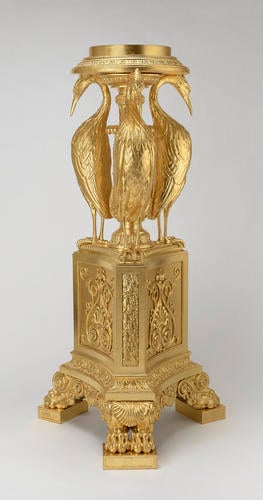Stand 1811
Carved and gilded wood | 134.0 x 70.5 x 62.2 cm (whole object) | RCIN 2423
-
Set of four tripod stands of carved and gilt beechwood. The circular dished top seemingly supported on the necks of three cranes flanking the turned central shaft, on a concave pedestal base applied with carved with scrolls; on three paired lions' paw feet, raised on rectangular plinths.
The pedestals may be those referred to in Jutsham's receipt from Mr.Tatham of "4 handsome carved & gilt tripods w Crane figures"; seen in the Crimson Drawing Room of Carlton House in the engraving published in W. H. Pyne's Royal Residences, 1819 after Charles Wild's watercolour of 1816.
The design of the pedestals may be inspired by G.-B. Piranesi's Vasi, Candelabri, Cippi ..., 1778, in particular pl. 26. The cranes, but not the claws of the plinth base feature on a number of designs by Charles Heathcote Tatham, including one published in 1806 in his Etchings representing Fragments of Grecian and Roman architectural ornaments, 1806, described as 'A Branch Light designed & executed in Bronze at Rome in the Year 1796'. Such a 'branch light' or candelabrum survives in the Royal Palace at Capodimonte, Naples and was probably designed by Giuseppe Boschi. Boschi had been recommended to Tatham by such luninaries as the sculptor Antonio Canova, Bonomi, Visconti and Angelika Kauffmann as a designer of antique-inspired modern furnishings. He was also cheaper than Righetti and Valadier (Proudfoot and Watkin, 'The furniture of Charles Heathcote Tatham', Country Life, 8 June 1972, p. 1482. Charles Heathcote Tatham had been sent to Rome in the 1790s by Henry Holland to gather designs of ancient ornaments, drawigns of which he sent back to England, and returned with a cache of plaster casts of ancient ornaments for use by Holland in his architectural work. This group of plaster casts were subsequently acquired in 1821 by the architect Sir John Soane and remain in the Sir John Soane's Museum. Charles Heathcote Tatham's brother, Thomas was a partner in the prolific cabinet-making and upholstery firm of which went by a number of names, but in 1811 was known as Tatham, Bailey and Sanders.
Part of the group of furniture and furnishings were restored between 1827 and 1829 for King George IV by the partnership of Morel and Seddon for the Library (now the Green Drawing Room) and His Majesty's Writing Room at Windsor Castle. Nicholas Morel had formerly worked for The Prince of Wales, later George IV, at Carlton House and the Royal Pavilion at Brighton. Subsequently, and in partnership with George Seddon, he was commissioned to design and furnish the newly built apartments designed by Sir Jeffry Wyattville (1766-1840) for the King at Windsor Castle. In order to fulfil the contract he entered into partnership with George Seddon III whose family had large and long established furniture workshops in Aldersgate Street in the City of London.Provenance
Supplied to the Prince Regent (later George IV), for Carlton House, June 1811.
-
Creator(s)
(furniture maker)(restorer)(nationality)Acquirer(s)
-
Medium and techniques
Carved and gilded wood
Measurements
134.0 x 70.5 x 62.2 cm (whole object)










